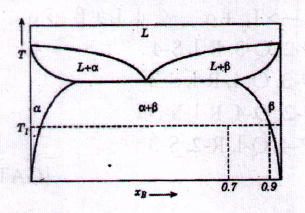71. It is possible to form martensite
72. The following reactions are written such that the forward reaction occurs during cooling. Match the reactions to their names.
Group-I
Group-II
P. Y = α + β
1. peritectoid
Q. L+ α = β
2. Eutectoid
R. L1 = L2 + α
3. Peritectic
S. α + β = Y
4. Monotectic
| Group-I | Group-II |
| P. Y = α + β | 1. peritectoid |
| Q. L+ α = β | 2. Eutectoid |
| R. L1 = L2 + α | 3. Peritectic |
| S. α + β = Y | 4. Monotectic |
73. Match the associated primary change in Group 2 with the corresponding phenomenon in Group 1.
Group 1
Group 2
P. Recovery
1. change in dislocation density
Q. Recrystallisation
2. change in the shape of a phase
R. Malleabilising
3. change in vacancy concentration
S. Texture
4. change in grain orientation
| Group 1 | Group 2 |
| P. Recovery | 1. change in dislocation density |
| Q. Recrystallisation | 2. change in the shape of a phase |
| R. Malleabilising | 3. change in vacancy concentration |
| S. Texture | 4. change in grain orientation |
74. An alloy of overall composition, XB = 0.7 was equilibrated at temperature T1. Microstructural analysis showed two phases, (α and β, and that the phase fraction of β was 0.75. Given that the equilibrium composition of β at Ti is 0.9 as shown in the phase diagram below, the maximum solubility of B in α (in mole fraction) at this temperature is . . . . . . . .


75. According to Griffith theory, which of the following are true for the fracture stress in a brittle material?
P. Increases with increasing surface energy
Q. Decreases with increasing elastic modulus
R. Decreases with increasing length of pre-existing crack
S. Decreases with increasing number of pre-existing cracks of same size
P. Increases with increasing surface energy
Q. Decreases with increasing elastic modulus
R. Decreases with increasing length of pre-existing crack
S. Decreases with increasing number of pre-existing cracks of same size
76. Match the following strengthening methods (Group I) in metallic alloys with typical mechanisms responsible (Group II) for them.
Group I
Group II
P. Grain size strengthening
1. Orowan looping
Q. Work hardening
2. Suzuki interaction
R. Dispersion strengthening
3. Lomer-Cottrell-barrier
S. Solid solution hardening
4. Dislocation pile up at grain boundaries
| Group I | Group II |
| P. Grain size strengthening | 1. Orowan looping |
| Q. Work hardening | 2. Suzuki interaction |
| R. Dispersion strengthening | 3. Lomer-Cottrell-barrier |
| S. Solid solution hardening | 4. Dislocation pile up at grain boundaries |
77. Which one of the following can avoid weld decay of austenitic stainless steels?
78. Lath martensitic microstructure we can see in
79. Regarding recrystalisation, which one of the following statements is not correct?
80. In age hardenable alloys maximum ductility is obtained
Read More Section(Physical Metallurgy)
Each Section contains maximum 100 MCQs question on Physical Metallurgy. To get more questions visit other sections.
